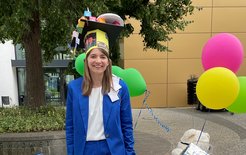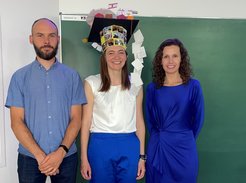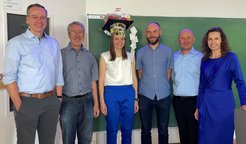Doctorate for Antonia Herzog
Today, Antonia Herzog defended her doctoral thesis at TU Berlin. She carried out research on size and shape-controlled copper-based nanocatalysts for the electrochemical conversion of carbon dioxide into feedstock chemicals and fuels.

Ms. Herzog made several excellent contributions to an improved operando mechanistic understanding in the difficult research area of the electrocatalytic CO2 Reduction Reaction (CO2RR) as well as catalyst design. She established operando Raman spectroscopy in the Interface Science Department and mastered various non-standard synchrotron techniques for her projects. She accomplished to combine synchrotron-based X-ray operando methods with Raman spectroscopy and participated in numerous national and international synchrotron beamtime trips related to X-ray absorption spectroscopy (XAS) and X-ray diffraction (XRD) measurements to unveil structure-composition-catalytic reactivity of catalysts.
In her defense, Ms. Herzog presented the scientific results on copper (Cu) catalyzed CO2RR via studies of silver decorated copper(I) oxide (Cu2O) nanocubes, of surface adsorbates on Cu2O as well as zinc oxide (ZnO)-decorated Cu2O during pulsed reaction conditions. These works led to highly important insights to better understand how liquid multi-carbon products in particular ethanol are formed.

Ms. Herzog showed that silver decoration especially improves the Faradaic efficiency of the liquid multi-carbon products. To identify the properties of the active catalysts state, she applied operando XAS and surface-enhanced Raman spectroscopy (SERS). Combined with the comprehensive post-mortem characterization of the catalyst structure, morphology and surface chemistry, she identified that the formation of silver-copper distances via the dispersion of silver (Ag) atoms or the formation of near-surface AgCu alloys on the oxide-derived copper host is linked to changes in the carbon monoxide (CO) adsorption configuration as well as the improved catalyst function. These findings highlight the importance of atomic level interaction between silver and copper which contrasts the widely discussed influence of a CO-rich reaction environment generated by the CO-producing Ag sites.
To link the catalyst function to the surface adsorbate configuration, Ms. Herzog applied time-resolved operando SERS achieving sub-second resolution. Thereby, she could show the different kinetics of CO adsorption depending on the pulse conditions as well as the differences in the average hydroxy (OH) to CO ratio on the surface.
Ms. Herzog revealed for the first time the importance of OH co-adsorption on the selectivity towards alcohols which was discussed for a long time but never confirmed experimentally in CO2RR.
In Addition, Ms. Herzog combined her methodical advancement on SERS complemented by operando time-resolved high-energy X-ray diffraction on ZnO-decorated Cu2O nanocubes during pulsed CO2RR. The synthesis yielded in a shell or frame of ZnO around the Cu2O nanocubes and she showed the addition of the CO-producing ZnO did not show an improvement in the catalyst selectivity under stationary reaction conditions. In contrast, pulsed CO2RR lead to a significant selectivity improvement towards multicarbon products for lower anodic pulse potentials leading to selective oxidation of the decorating Zn species.

Her operando studies confirm differences in the extend and kinetics of the Zn and Cu redox transitions during the pulsed CO2RR as well as revealed the influence of the reaction conditions on the surface adsorbates. In agreement with her findings she showed a key role of the co-adsorbed OH on the catalyst surface. This work furthermore yielded in highly important insights which will help to improve catalyst design e.g. for pulsed CO2RR as well as the operating conditions combined with mechanistic insights.
Within the last four years, Ms. Herzog was able to publish eleven peer-review articles in high impact journals like Nature Catalysis, Angewandte Chemie, Journal of the American Chemical Society and ACS Catalysis. She is first author of one of them, in addition two more first author publications, which are part of her thesis, are currently in preparation.
The full title of Antonia Herzog's thesis is “Operando Insights into Size and Shape-controlled Cu-based Nanocatalysts for the Electrochemical Reduction of CO2 toward C2+ Products”.
More inormation on Antonia Herzog:
Research Gate
Max Planck Publications














